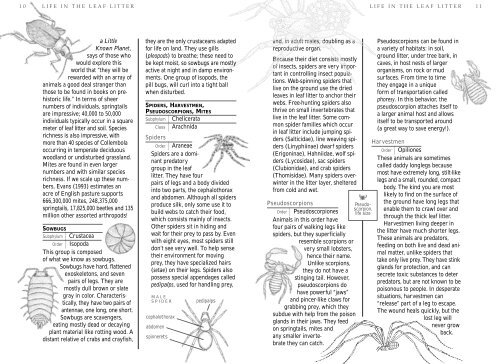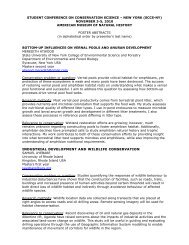Life In The Leaf Litter - American Museum of Natural History
Life In The Leaf Litter - American Museum of Natural History
Life In The Leaf Litter - American Museum of Natural History
You also want an ePaper? Increase the reach of your titles
YUMPU automatically turns print PDFs into web optimized ePapers that Google loves.
10 LIFE IN THE LEAF LITTER<br />
a Little<br />
Known Planet,<br />
says <strong>of</strong> those who<br />
would explore this<br />
world that “they will be<br />
rewarded with an array <strong>of</strong><br />
animals a good deal stranger than<br />
those to be found in books on prehistoric<br />
life.” <strong>In</strong> terms <strong>of</strong> sheer<br />
numbers <strong>of</strong> individuals, springtails<br />
are impressive; 40,000 to 50,000<br />
individuals typically occur in a square<br />
meter <strong>of</strong> leaf litter and soil. Species<br />
richness is also impressive, with<br />
more than 40 species <strong>of</strong> Collembola<br />
occurring in temperate deciduous<br />
woodland or undisturbed grassland.<br />
Mites are found in even larger<br />
numbers and with similar species<br />
richness. If we scale up these numbers,<br />
Evans (1993) estimates an<br />
acre <strong>of</strong> English pasture supports<br />
666,300,000 mites, 248,375,000<br />
springtails, 17,825,000 beetles and 135<br />
million other assorted arthropods!<br />
SOWBUGS<br />
Subphylum | Crustacea<br />
Order | Isopoda<br />
This group is composed<br />
<strong>of</strong> what we know as sowbugs.<br />
Sowbugs have hard, flattened<br />
exoskeletons, and seven<br />
pairs <strong>of</strong> legs. <strong>The</strong>y are<br />
mostly dull brown or slate<br />
gray in color. Characteristically,<br />
they have two pairs <strong>of</strong><br />
antennae, one long, one short.<br />
Sowbugs are scavengers,<br />
eating mostly dead or decaying<br />
plant material like rotting wood. A<br />
distant relative <strong>of</strong> crabs and crayfish,<br />
they are the only crustaceans adapted<br />
for life on land. <strong>The</strong>y use gills<br />
(pleopods) to breathe; these need to<br />
be kept moist, so sowbugs are mostly<br />
active at night and in damp environments.<br />
One group <strong>of</strong> isopods, the<br />
pill bugs, will curl into a tight ball<br />
when disturbed.<br />
SPIDERS, HARVESTMEN,<br />
PSEUDOSCORPIONS, MITES<br />
Subphylum | Chelicerata<br />
Class | Arachnida<br />
Spiders<br />
Order | Araneae<br />
Spiders are a dominant<br />
predatory<br />
group in the leaf<br />
litter. <strong>The</strong>y have four<br />
pairs <strong>of</strong> legs and a body divided<br />
into two parts, the cephalothorax<br />
and abdomen. Although all spiders<br />
produce silk, only some use it to<br />
build webs to catch their food,<br />
which consists mainly <strong>of</strong> insects.<br />
Other spiders sit in hiding and<br />
wait for their prey to pass by. Even<br />
with eight eyes, most spiders still<br />
don’t see very well. To help sense<br />
their environment for moving<br />
prey, they have specialized hairs<br />
(setae) on their legs. Spiders also<br />
possess special appendages called<br />
pedipalps, used for handling prey,<br />
MALE<br />
SPIDER<br />
cephalothorax<br />
abdomen<br />
spinnerets<br />
pedipalps<br />
and, in adult males, doubling as a<br />
reproductive organ.<br />
Because their diet consists mostly<br />
<strong>of</strong> insects, spiders are very important<br />
in controlling insect populations.<br />
Web-spinning spiders that<br />
live on the ground use the dried<br />
leaves in leaf litter to anchor their<br />
webs. Free-hunting spiders also<br />
thrive on small invertebrates that<br />
live in the leaf litter. Some common<br />
spider families which occur<br />
in leaf litter include jumping spiders<br />
(Salticidae), line weaving spiders<br />
(Linyphiinae) dwarf spiders<br />
(Erigoninae), Hahniidae, wolf spiders<br />
(Lycosidae), sac spiders<br />
(Clubionidae), and crab spiders<br />
(Thomisidae). Many spiders overwinter<br />
in the litter layer, sheltered<br />
from cold and wet.<br />
Pseudoscorpions<br />
Pseudoscorpion,<br />
Order | Pseudoscorpiones life size<br />
Animals in this order have<br />
four pairs <strong>of</strong> walking legs like<br />
spiders, but they superficially<br />
resemble scorpions or<br />
very small lobsters,<br />
hence their name.<br />
Unlike scorpions,<br />
they do not have a<br />
stinging tail. However,<br />
pseudoscorpions do<br />
have powerful “jaws”<br />
and pincer-like claws for<br />
grabbing prey, which they<br />
subdue with help from the poison<br />
glands in their jaws. <strong>The</strong>y feed<br />
on springtails, mites and<br />
any smaller invertebrate<br />
they can catch.<br />
LIFE IN THE LEAF LITTER 11<br />
Pseudoscorpions can be found in<br />
a variety <strong>of</strong> habitats: in soil,<br />
ground litter, under tree bark, in<br />
caves, in host nests <strong>of</strong> larger<br />
organisms, on rock or mud<br />
surfaces. From time to time<br />
they engage in a unique<br />
form <strong>of</strong> transportation called<br />
phoresy. <strong>In</strong> this behavior, the<br />
pseudoscorpion attaches itself to<br />
a larger animal host and allows<br />
itself to be transported around<br />
(a great way to save energy!).<br />
Harvestmen<br />
Order | Opiliones<br />
<strong>The</strong>se animals are sometimes<br />
called daddy longlegs because<br />
most have extremely long, stilt-like<br />
legs and a small, rounded, compact<br />
body. <strong>The</strong> kind you are most<br />
likely to find on the surface <strong>of</strong><br />
the ground have long legs that<br />
enable them to crawl over and<br />
through the thick leaf litter.<br />
Harvestmen living deeper in<br />
the litter have much shorter legs.<br />
<strong>The</strong>se animals are predators,<br />
feeding on both live and dead animal<br />
matter, unlike spiders that<br />
take only live prey. <strong>The</strong>y have stink<br />
glands for protection, and can<br />
secrete toxic substances to deter<br />
predators, but are not known to be<br />
poisonous to people. <strong>In</strong> desperate<br />
situations, harvestmen can<br />
“release” part <strong>of</strong> a leg to escape.<br />
<strong>The</strong> wound heals quickly, but the<br />
lost leg will<br />
never grow<br />
back.

















